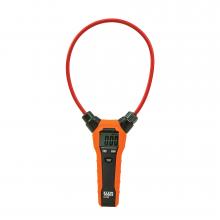Electrical Tester, HVAC Clamp Meter with Differential Temperature
CL450
Electrical Tester measures AC/DC voltage up to 1000V, 600A AC Current, 60MOhms Resistance, DC millivolts and microamps
Amp Clamp with automatically ranging True Root Mean Squared (TRMS) measurement technology for accuracy CAT IV 600V, CAT III 1000V, Class 2, Double insulation safety rating
Clamp measures AC current and inrush current
Two K-Type thermocouple ports for differential temperature measurements
Test leads measure AC/DC voltage, DC microamp, resistance, LoZ, continuity, frequency, duty-cycle, capacitance, and diodes
Dedicated mode for capturing DC microamp and inrush current
Low-Pass filter and Low impedance (LoZ) mode for identifying and eliminating ghost or stray voltages
Dual backlit 6000 LCD display for clear visibility in environments with low ambient lighting
Rugged design with a 6.6-Foot (2 m) drop protection and a CAT IV 600V Safety Rating
Includes carrying case, instruction manual, straight input test leads, two K-type thermocouples, and 3 x AAA batteries
Can be used with Magnetic Hanger Cat. No. 69417 (sold separately)
Use with K-Type Temperature Pipe Clamp Cat. No. 69140, and K-Type Temperature Probe Cat. No. 69144 (sold separately)
Klein Tools CL450 Clamp Meter with dual display is a ''game changer'' for the HVAC professional. It measures AC/DC voltage up to 1000V, 600A AC Current, 60MΩ Resistance, DC millivolts and microamps. This True RMS CAT IV 600V meter offers differential temperature, digital temperature calibration, inrush current and many other functions for HVAC applications.
Specifications
California residents:
![]() WARNING: Cancer and reproductive harm - See www.P65Warnings.ca.gov for more information.
WARNING: Cancer and reproductive harm - See www.P65Warnings.ca.gov for more information.
Warnings
- Never use the meter on a circuit with voltages that exceed the category based rating of this meter.
- Read, understand and follow all instructions, cautions and warnings attached to and /or packed with all test and measurement devices before each use.
- Do not use the meter during electrical storms or in wet weather, and do not use the meter or test leads if they appear to be damaged.
- Before each use verify meter operation by measuring a known voltage or current.
- Always adhere to local and national safety codes. Use personal protective equipment to prevent shock and arc blast injury where hazardous live conductors are exposed.








